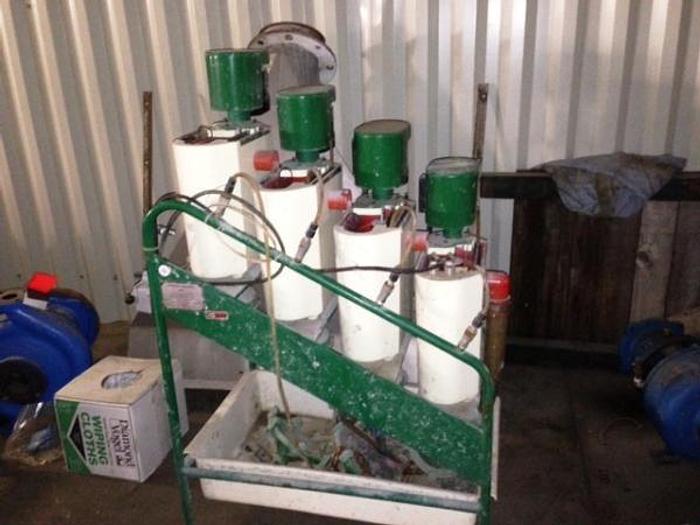Sprout Bauer Fibre Classifier

Sprout Bauer Fibre Classifier
or
Call 001 (612) 850-5936
Description
Bauer-McNettFinerClassifier
Model203
INTRODUCTION
Atreeismadeoffibresthatdiffergreatly
inlength,widthandcoarseness.Thedifferences
betweenfibreswithinatreecanbeas
greatasthedifferencesbetweenspecies.However
thetraditionalapproachofpreparingfibres
forpapermakingistopulpthewoodandprocess
thefibresasacollective–refiningthe
wholepulptoshortentheaveragefibrelength,
forexample.Thisapproachsimplifiestheprocess
design,butneglectstheopportunitytoexploit
theinherentbenefitsoftheindividualfibre
fractions.
Fibrefractionationisaprocessthatsegregates
ablendofpulpfibresintodifferent
streamsbasedonsomephysicalpropertyofthe
fibres,suchastheirlengthorflexibility.The
fibresofaparticulartypecanthenbedirectedto
themostappropriateprocessandproduct.A
pulpproducerwithtwopulpmachines,forexample,
couldfractionatethefibresandincrease
thecontentoflongfibresononemachineto
provideahigh-valuereinforcingpulp.Alternatively
apaperproducerwithamulti-layer
headboxcoulddirecttheshorterfibrestothe
surfacelayerstoimprovesheetsmoothness,
whileplacingthelongerfibresinthecoreto
providestrength.Withinthemillsystem,one
couldconcentratelong,stifffibresinthefeedto
therejectrefinertosaveenergyandincrease
capacity,whileavoidingthedegradationof
fibresthatarealreadyacceptable.
Theopportunitiesforfibrefractionation
areclear,buttheuseoffractionationtechnology
inindustryremainslimited.Theboardindustry
usesfractionationtooptimizethe
characterofthedifferentlayers[1–3].Inrecycled
fibreproduction,fibrefractionationand
subsequentprocessinghavebeenshowntoimprove
strengthandbrightness,andtoreduceenergy
consumption[4].Howevertheabsenceof
equipmentwhichcanprecisely,efficientlyand
economicallyfractionatefibreshaslimitedthe
widespreadpracticeoffractionationinmilloperations.
Thepromiseoffractionationhasbeen
established,inpart,throughtheuseoflaboratory
fractionationequipmenttoseparateindividual
pulpfractionsandformpaperwith
optimalfibreblends.TheBauer-McNett
classifier(BMC)isthemostwidespreadofthe
laboratorydevices,anditiscommonlyusedto
assesstheleveloffractionationobtainedwith
pressurescreensandotherprocessequipment.
TheBMCoperatesbytheselectivepassage
offibresthroughascreenmesh.Itseparates
fibresmainlyonthebasisoflength,
althoughthefundamentalprinciplesofoperation
arenotwellunderstood[5–12].Thepractice
ofusingthislaboratoryscreentoevaluate
pressurescreensraisesseveralimportantquestions:
—DoaBMCandapressurescreenoperateusing
thesameprincipleofseparation?
—TowhatextentdoesaBMCprovideideal,
precise,length-basedfractionation?
—DoesaBMCprovideinsightsonhowpressure
screenscanbeoptimizedforoptimal
fractionation?
Toanswerthesequestions,thisstudyreviews
howfractionationisassessed,andhow
indicesoffractionationareappliedtoindustrial
pressurescreens.AflowmodelofaBMCis
thendeveloped,andexperimentalmeasurements
areusedtoassessthevalidityofthe
modelandtheleveloffractionationobtained.
Finally,theextentoffractionationwithaBMC
iscomparedtopublishedvaluesforindustrial
pressurescreens.
FRACTIONATIONTHEORY
Thepassageoffibresthroughscreensis
describedbytheirpassageratio(P),whichis
theconcentrationofaparticular classoffibres
intheflowpassingthroughascreenplateaperture
relativetotheconcentrationapproaching
theaperture[13].Forthefractionationoffibres
onthebasisoflength,onewishestohavethe
shortfibrespassingfreelythroughthescreen(P
equalto1)whilenolongfibrespassthrough(P
equalto0).Itisappropriatetoassessfractionation
bymeasuringpassageratioasafunction
R.W.Gooding*andJ.A.Olson**
Paprican
PointeClaire,QC,Canada
H9R3J9
*Nowwith:
CAEForestrySystems
4635PatriciaAve.
Montreal,QC,Canada
H4B1Z2
(robertg@caescreenplates.com)
**Nowwith:
Dept.MechanicalEngin.
Univ.BritishColumbia
2324MainMall
Vancouver,BC,Canada
V6T1Z4
AnanalyticmodeloftheBauer-McNett classifier(BMC)wasderivedandtested.ThestudyshowedthattheBMC classifiesfibresmainlybylength.
Overlapinthelengthdistributionof classesreflectsthestatisticalnatureoftheBMCoperationratherthantheinfluenceofsomeotherfibrequality.
Thefundamentalqualityoffibrelengthfractionationwassimilartothatfoundinanindustrialpressurescreen.
Unmodèleanalytiquedu classificateurBauer-McNett(BMC)aétédérivéetmisàl’essai.L’étudeadémontréqueleBMC classelesfibressurtout
selonleurlongueur.Lechevauchementdanslarépartitiondeslongueursdes classesreflètelanaturestatistiquedufonctionnementduBMCplutôtque
l’influenced’uneautrequalitédelafibre.Laqualitéfondamentaledufractionnementdelalongueurdesfibresétaitsimilaireàcellequel’onretrouve
dansun classeursouspressionindustriel.
oflength(P(l)).
Thepassageoffibresthroughscreens,
andP(l)inparticular,hasbeenstudiedtheoretically
andexperimentally[14–16].Acharacteristic
curvehasbeenproposedbyOlsonto
describethisrelationship[17]*:
P(l)
e
1
(1)
whereandaredimensionlessconstantswith
specificsignificance,asshowninFig.1.The
valueofcanbeseenasa“shapeconstant”inasmuch
asOlsonhasreportedavalueofequal
to0.5forslottedpressurescreensandavalueof
1.0forholedscreens.Highervaluesofindicate
thatthescreenapproachestheidealformof
astepcurve.Thevalueofisa“sizeconstant”
andexperimentaltestshaveshownthatlarger
holesandslotsleadtolargervaluesof[17,18].
AkeyteachingofFig.1isthat,fora
*Whilereference[17]isthefirstpublicappearance
ofthisequation,itwasderivedindependently
byRobertGoodingand
publishedinaninternalPapricanreportin
March1992.
0
0.2
0.4
0.6
0.8
1
01234567
Fibrelength(mm)
Passageratio
=10
1
4
A
=0.5
0
0.2
0.4
0.6
0.8
1
01234567
Fibrelength(mm)
=10
4
1
B
=1.0
4=10
1
C
=5.0
Fig.1.CharacteristicformsoftheP(l)curveforarangeofandvalues.
Avalueof=0.5(A)istypicalforscreenswithslots;=1.0is
typicalforscreenswithholes(B)andhighvaluesof(C)denotenearideal
fractionation.
Fig.2.PhotographofaBauer-McNett classifier.
Fig.3.SchematicofBMCchamberinplanview.Theinletflowisshown
enteringfromthetop.Thereisacirculatoryflowwhichisdriven
(clockwise)bytherotorattheright.Partofthecirculatoryflowsplits
offandpassesthroughthescreenmesh(dashedline)atthebottom.
TABLEI
BAUER-McNETTCLASSIFIERSPECIFICATIONS
Samplesizeofpulp10g(o.d.)
Activevolumeofachamber19.8L
Standardflow-throughrate12L/min
Upstreamvelocity2~2m/s
Totalareaofscreenmesh0.033m2
Openareaofscreenmesh14mesh0.014m2
28mesh0.012m2
Aperturevelocity(average)0.02m/s
Aperturesize14mesh1.2x1.2mm
28mesh0.6x0.6mm
Wirediameter14mesh0.65mm
28mesh0.39mm
1.Thisincludestheadditionalvolumeresultingfromtheheaddriving
theflowtothefollowingtank.
2.Estimatedasthetipspeedoftheimpeller.
fixedvalueoftheshapeconstant,,smaller
valuesofthesizeconstant,,willreducenot
onlythepassageoflongfibres,butshortfibres
too.Thuspurifyingthestreamofshortfibres
throughthescreenplateisdoneattheexpense
ofcontaminatingthestreamoflongfibreswith
shortmaterial.Increasingthevalueofhowever,
leadstoincreasedpassageofshortfibre
andreducedpassageoflongfibre.Thusisthe
essentialparameterinassessingthequalityof
fractionation.
ToapplyP(l)totheperformanceofindustrial
pressurescreens,oneneedsamodelof
howtheflowthroughindividualaperturesrelates
totheoverallflowsthroughapressure
screen.Apulpscreentakesasinglefeedstream
anddividesitintoacceptandrejectstreams.
Thequalityoffractionationismeasuredby
consideringtheextentthatthelongandshort
fibresgototheirtargetstreams,i.e.thatlong
fibresgototherejectoutletandtheshortfibres
gototheacceptoutlet.Tosimplifytheanalysis,
onecanmeasurethefractionofshortfibres
leavingviatherejectstreaminsteadofthefraction
ofshortfibresgoingtotheacceptstream
sincetheacceptandrejectstreamsarecomplementary.
Aremovalfunctione(l)hasbeendefined
asthemassfractionoffibresoflengthlthat
passfromthefeedtorejectoutlet[19].Byassuming
plugflowaxiallythroughthescreen,
onefindsthat:
e(l)RV()
Pl
(2)
whereRVisthevolumetricrejectratio,equalto
thevolumetricrejectflowratedividedbyfeed
flowrate.Theplugflowassumptionissupported
byseveralexperimentalstudies
[17,18,20].
Theremovalfunction,e(l),isusedto
provideadetailedunderstandingoffibrefractionation
inscreening.Itcanalsoberelatedto
theparameterscommonlyusedtoassessfractionation
inindustrialterms.Theseparameters
arethe“longfibreremovalratio”(alsoknown
asthe“longfibreremovalefficiency”)andthe
“shortfibreremovalratio”(whichisrelatedto
themassrejectrate).Thelongfibreremovalefficiency,
EL,isdefinedasthemassfractionof
longfibres(i.e.fibresgreaterthanthespecified
“cut-off”length)thatgofromthefeedtothereject
outlet.ThevalueofELcanbeobtainedby
usingalabdevicesuchastheBMCtomeasure
themassfractionoflongfibresinfeedandreject
samples,orbyaveraginge(l)overtherange
offibrelengthsabovethe“cut-off”value.Similarly,
theshortfibreremovalratio,Es,isobtained
byaveraginge(l)overtheshortfibre
lengths.
Inidealfractionation,EL=100%andES
=RV.FollowingfromEq.(2),idealfractionation
impliesPL=0andPS=1,whichisconsistent
withthenear-idealstep-curverelationship
indicatedinFig.1C.Whileitwouldbedesirable
tohaveES=0,thelimitingconditionin
screeninghasverysmallparticlesfollowingthe
flowsplit,whichleadstoES=RV.
Fractionationparametershavebeenproposed
tocombinetheimpactofELandES.One
parameter,hasbeendefinedasthedifference
betweenELandES[18]:
ELEs(3)
Thevalueofisequalto0whenthereisno
fractionation,andapproaches1asfractionation
increases.Thisparameterisa“valuecharacteristic”
forthespecificcasewherethe
economicbenefitofincreasedELisequaltothe
penaltyofincreasedES.Itisofparticularusefor
controlpurposes.
Anotherfractionationparameter,is
definedintermsofthepassageratiosofthe
longandshortfibres:
1
P
P
L
S
(4)
Thevalueofisa“performancecharacteristic”
foraparticularscreeningconfiguration,andits
usecomplementsthatof.Assumingaplug
flowmodelofflowthroughapulpscreen,EL
andESarerelatedasfollows:
ELE1S(5)
Thevalueofincreasesfromavalueof0,
wherePL=PS,EL=ESandthereisnofractionation,
toavalueof1foridealfractionation,
wherePL=0andEL=1.Animportantattribute
ofisthatitisindependentoftherejectratio,
whichisthechiefoperatingvariableofascreen.
Thusisafundamentalreflectionofthepulp
characterandscreenplateconfiguration.
Regardlessofwhetheronemonitorsor
thekeypointisthatthevaluesofanddetermine
PLandPS,whichhaveadirectlinkto
ELandESandtheperformanceofindustrial
pressurescreens.SincetheBMChasbeenused
bothtoassessfibrelength(formeasurementsof
EL)andasamodeloffractionation,thereisa
keeninterestinassessingthevaluesofand
obtainedwiththisdevice.
BAUER-McNETTCLASSIFIER
TheBMCisalaboratorydevicethatis
usedtoassessthesizedistributionoffibres.
ThedeviceisshowninFig.2andstandard
methodsexistforitsuse[21,22].Itconsistsofa
seriesofchambers,typicallyfourorfive,each
withaprogressivelysmallerscreenmesh.At
thestartofatest,aprescribedamountofpulpis
pouredintothefirstchamber.Acontinuous
flowofwaterpassesthroughthischamberand
theseriesofchambersthatfollow.Smaller
fibresarecarriedbytheflowthroughthemesh
andtothefollowingchamberor,inthecaseof
thefinalchamber,tothesewer.Attheendofthe
testperiodtheflowisstopped,thechambersare
drained,andthemassineachchamberismeasured.
Thusapulpwithsmallerfibreswillhave
moremassinthechamberswiththesmaller
meshsizes.
Forthesakeofsimplicity,theanalysis
andexperimentsinthisstudyonlyconsiderthe
performanceofasinglechamberintheBMC,
thoughtheycouldbeextendedtotheperformance
oftheoverallunit.Theelementsofasingle
chamberareshownschematicallyinFig.3
andkeyparametersarelistedinTableI.Anindustrial
pressurescreenandtheBMCboth
causeundersizefibrestopassthroughascreen
plate.Theaperturesineachdeviceareroughly
thesamesize.However,therearesomeimportant
differencesbetweenthesetwodevices.The
BMChasanupstreamvelocityofabout2m/s
andaperturevelocityof0.02m/s,whileapressure
screenhasanupstreamvelocityofabout5
m/sandaperturevelocityof2to4m/s.The
maximumconsistencyintheBMCis0.1%versus
atypicalfeedconsistencyof1.5–3%ina
pressurescreen.TheBMChasascreenmesh
whileapressurescreenusesasolidmetalplate
withholesorslots.Also,theBMChasanimpeller
whichmovestheflowpastthemeshsurface
andcausesmixinginthechamberbut,
unlikeapressurescreenrotor,doesnotproduce
pressurepulsationswhichbackflushthemesh
apertures.ThustheBMCapertureflowisrelatively
steady,whilethepressurescreenhassubstantial
flowreversals.
Inatypicalexperiment,theresidual
oven-drymasswasmeasuredusingahot-plate
technique,andthefibrelengthdistributionwas
assessedusingaKajaaniFS-200FibreLength
Analyzer,whichmeasuresfibrelengthwitha
precisionof0.05mm.Thelength-weightedfibre
lengthdistributionwasthenusedtoestimate
thetotalmassoffibresinvariouslength
classes.Todeterminethepassageratiooffibres
ineachlength class,amixedflowmodelwas
appliedtothechamber.Thustheamountof
fibrespassingthroughthemesh(dM)inaperiod
oftime(dt)wasassumedtobeproportional
tothevolumetricflowrate(Q),the
passageratio(P)andtheinstantaneousconcentration
offibresinthechamber(C):
dMQPCdt(6)
Fibreconcentrationisthemass(M)dividedby
thevolumeofthechamber(V).Substitutingthis
definitionintoEq.(6)andintegratingfromthe
initialmassinstalledinthechamber(M0)at
timeequaltozeroyields:
M
M
QPt
V
0
e(7)
Equation(7)mayberewrittenintermsofthe
numberofreplacements(R)thatpassthrough
thechamber:
M
M
RP
0
e(8)
where“replacements”representthetotalflow
throughthechamberdividedbythevolumeof
thechamber,andareassumedinthisanalysisto
betheessentialfactorindepletingmassinthe
chamber:
R
Qt
V
(9)
Onecanalsore-arrangeEq.(8)toprovidean
expressionforP:
P
R
M
M
1
0
ln(10)
Bymeasuringtheinitialandfinalmassoffibres
ineachsize(i.e.length)fraction,Eq.(10)canbe
usedtogenerateP(l)fromexperimental
measurements.
EXPERIMENTALFINDINGS
Sevenexperimentswereconductedin
thisstudyandtheexperimentalprogramis
giveninTableII.Areslushed,softwoodTMP
fromtheBritishColumbiainteriorwasusedfor
allexperiments.Thepulphadafreenessof200
CSFandwassubjectedtostandardprocedures
fordisintegrationandlatencyremoval.
DegreeofSegregation
Thefirsttestwasmadetoestablishthe
qualityoflengthseparationachievedwiththe
BMC.AsseeninFig.4,theBMCsortsfibres
onthebasisoflengthbutdoesnotprovidea
preciseandcompletesegregationofthefibres.
Chamberswithlargermeshsizesretainlonger
fibres,asexpected.Howevertherangeoffibre
lengthsinaparticular classissubstantialand
thereissignificantoverlapbetweendifferent
classes.Forexample,1.5–2.5mmfibrescomprise
oneofthelargest classesoffibrelength
withintheR28 classification,butsignificant
amountsofthesefibresarealsofoundinthe
R14andR48 classes.Theseobservationsare
consistentwiththosebyJackson[23].
Figure5presentsthecombinedresults
ofTrials1to3fortheR14 class.Oneseesthat
certainfibres,suchasthoseinthe3.5–4.5mm
class,arealmostcompletelyretained,irrespective
ofthetimespentinthechamber.Others,
suchasthe1mmfibres,havealmostcompletely
passedoutofthechamberinthe20min
recommendedoperatingtime.Fibresinthe
veryimportant2–3mm classappeartobediminishing
inagradualwaysuggestiveofarandom
orstatisticalpassage.
StatisticalPassage
Astatisticalmodelofpassagewasassumed
inthemodeloftheBMC.ThisledtoEq.
(7),whichhasanexponentialform.Figures5to
7showdatapointsthatreflectthedecayinthe
massoffibresfromparticular classesasafunction
oftime.AlsoshowninFig.6arecurvesfit
tothedatausingtheexponentialformofEq.
(7).Thegoodfitprovidessupportforthestatistical
modeloftheBMC.
Thestatisticalmodelpresentedabove
prescribesthatthediminutionofmassisdetermined
bythenumberofreplacementsthatpass
throughthechamber(Eq.9).Thiswasinvestigated
byalsochangingtheflowratethroughthe
BMCinTests4and5.Figure7includesthe
datafromthechangingflowrateaswellasthe
datainFig.6.Theresidualmassfractionis
TABLEII
EXPERIMENTALPROGRAM
TestNo.MeshFlowRateDuration
1234567
All1
14
14
14
14
14
28
12L/min
12
12
15
9
12
12
20min
10
5
10
10
10
10
FibreLength(mm)
Massdensity(g/mm)
0123456
0
1
2
3
4
5
Total
R14
R28
R48
R100
R200
Fig.4.Fibrelengthdistribution(massdensity)ofpulpfromindividual
BMC classes.
FibreLength(mm)
Massdensity(g/mm)0
1
2
3
4
5
6
0
1
2
3
4
5
INITIAL
5min
10min
10min(replicate)
20min
Fig.5.Themassdensity–fibrelengthdistributionintheR14chamber
asafunctionoftime.Notetheexcellentreproducibilityofresultsfor
thereplicatetrialsof10minduration.
Time(min)
Massfraction
0.005101520
0.2
0.4
0.6
0.8
1.0
0-1mm
1-2mm
2-3mm
3-4mm
Fig.6.ExponentialdecayofmassintheR14containerfordifferentfibre
lengthranges.Massisexpressedasafractionoftheinitialmass
foreachfibrelength.Replicatemeasurements(at10min)appearalmost
coincident.ThefitcurvesusetheformofEq.(7).
Replacements
Massfraction
0510152025
0.0
0.2
0.4
0.6
0.8
1.0
0-1mm
1-2mm
2-3mm
3-4mm
Fig.7.ExponentialdecayoffibremassintheR14 classasafunction
ofreplacementvolumes.FitcurvesareoftheformofEq.(8).Datawere
obtainedbyvaryingboththedurationofthetrialandtheflowrate.
plottedasafunctionofreplacementsrather
thantime.Theadditionaldatafittheexponential
formofthefitcurveswell.
P(l)Curves
ThedatainFigs.5to7supporttheuseof
astatistical/perfect-mixingmodelfortheflow
offibresfromtheBMC.ItfollowsthatEq.(10)
canbeusedtoprovidetheP(l)curvewhich
characterizesthequalityoffractionationobtained
inaBMC.ThesedataareshowninFig.
8,whichincludesacurveoftheformofEq.(1).
Theexcellentmatchbetweenthetrendsinthe
dataandthecurveformsupportstheapplication
ofEq.(1)(proposedforindustrialpressure
screens)totheBMCandsuggeststhatitmay
haveageneralapplicabilitytopulpscreening
devices.
Thevalueofobtainedbyaleastsquares
fitwas0.97,whichisveryclosetothe
valueof1.0proposedbyOlsonetal.[17]for
pressurescreenswithholes.Itisnotoverlysurprising
thatasquarehole(intheBMCmesh)
hadthesameshapeconstant(asaroundhole
inthepressurescreen.Morecuriousisthatthe
absenceofpressurepulsationsdidnothavean
effectonHowever,qualitativeinspectionof
theflowpatternswithintheBMCsuggestssubstantial
mixingintheflowadjacenttothemesh,
whichmightbeproducingthesameeffectas
thepulses.Avalueofequalto0.82wasobtained
fortheR14mesh(with1.2mmsquare
openings)which,comparedtothevaluesreported
byOlsonetal.[17]forpressurescreens,
suggeststhattheaperturesintheBMCactlike
smallerholesthaninapressurescreen.
P(l)datafortheR28BMC classare
showninFig.9alongwiththecurvefitusing
theinitialpulpchargewasplaceddirectlyinthe
R28chamberatthestartofthistestandtheR14
chamberwasnotused.Theexcellentmatchof
thedatatothecurveformgivesfurthersupport
totheuseofEq.(1)forcharacterizingfractionation.
Moreoverthegoodfitmadeusing
indicatesthefundamentalqualityoffractionation
didnotchangewiththesizeoftheaperture.
Thelowervalueofisconsistentwith
previousfindingsforpressurescreensthatindicate
lowervaluesofforsmallerscreenapertures.
CONCLUSIONS
Theconclusionsofthisstudycanbe
statedinthecontextofquestionsposedatthe
startofthisreport.
DoaBMCandapressurescreenoperate
usingthesameprincipleofoperation?
Despitethesignificantdifferencesinthe
overallconfigurationandoperationofaBMC
andpressurescreen,theessentialmechanism
thatgovernsfibrepassageatanapertureappears
quitesimilar.Thisstudydemonstrated
thatthemixed-flowmodelworkswelltodescribe
theperformanceoftheBMC,andtheexponential
modeloffractionationfitstheP(l)
fractionationcurveverywell.Likeanindustrial
pressurescreen,theBMCoperatesby“probability
screening”.Thisraisesquestionsabout
theuseofoneprobabilityscreen(i.e.theBMC)
toevaluateanother,suchasanindustrialpressure
screen.However,itestablishesthatthe
BMCmaybeusedtobetterunderstandthefundamentals
ofscreenoperation.
TowhatextentdoesaBMCprovideideal,
precise,length-basedfractionation?
Thehighdegreeofdilutionandlowreject
ratiointheBMCprovidesgoodsegregation
ofcertainsizedfibres,butthereare
substantialrangesoffibresthatareonlypartly
segregatedintheBMC.Thismitigatesagainst
theuseoftheBMCasanabsolutemeasurement
offibrelengths.Thedegreeoffractionation,i.e.
thevaluesfortheshapeconstant()andsize
constant(),iscomparabletothatfoundinan
industrialpressurescreen.
DoesaBMCprovideinsightsonhow
pressurescreenscanbeoptimizedfor
optimalfractionation?
Thefindingthatforthesquaremesh
aperturesintheBMCisthesameasthatfora
pressurescreenwithholesreinforcesthe
thoughtthatrepresentsashapeconstantfor
screenoperation.Sincefractionationinthe
BMCandinpressurescreensoperatesbyprobability
screening,theshapefactormayrepresent
thedegreeofrestraintthattheaperture
imposesonthesomewhatrandomwaythat
fibresapproachanaperture.Aholeimposesa
higherdegreeofconstraintthanaslotbecause,
foraslot,longfibreshavethepotentialofbeing
alignedwiththeslotlengthandpassing
through.Idealfractionation(i.e.highvaluesof
wouldappeartorequireamechanismforapplying
furtherdegreesofconstraint.Increasing
thedegreeofconstraintintheBMCorsome
otherlab-scalefractionationtechnique,which
canbemodifiedrelativelyeasilyandoperated
undercontrolledconditions,maybeauseful
steptowardsthelargergoalofincreasingfractionation
onanindustrialscale.
Thisstudyhasprovidedacautionary
messageaboutusingtheBMCasanabsolute
measureoffibremeasurement.Atthesame
time,ithasrevealedanopportunitytousethe
BMCasadevicetoexplorethefundamentalsof
fractionation.
REFERENCES
1.COX,M.T.,“ApplicationofHotStockPulp
FractionationatMeadCoatedBoard”,Proc.
1989TAPPIPulpingConf.,1–4.
2.KOHRS,M.,“TheApplicationsforFractionation
(1992).
3.MUSSELMANN,W.andMENGES,W.,“Concept
andFunctionofaWastepaperFibreFractionation
SystemandPracticalOperating
Experience”,Woch.furPapierfab.11/12:
368–379(1982).
4.MAYOVSKY,J.,“FractionationofOCC.How
CanItHelpYou?”,RecyclingSymp.,407–416
(1998).
5.ANDERSSON,O.,“AnInvestigationofthe
HillbomandBauerMcNettFibreClassifiers”,
6.BENTLEY,R.G.,SCUDAMORE,P.andJACK,
J.S.,“AComparisonBetweenFibreLength
MeasurementMethods”,PulpPaperCan.
Specifications
| Condition | Used |
| Stock Number | 982 |
| Journalofpulpandpaperscience | VOL.27NO.12DECEMBER2001425 |
| 424journalofpulpandpaperscience | VOL.27NO.12DECEMBER2001 |
| 426journalofpulpandpaperscience | VOL.27NO.12DECEMBER2001 |
| 1.thestandardsetofbmcscreensare | 14,28,48,100and200mesh. |
| Eq.(1).note | UnlikestandardBMCoperation, |
| Technology”,papertechnol.33(3) | 10–12 |
| Svenskpapperstidn.56(18) | 704–709(1953). |
| 95(4) | 41–45(1994). |


